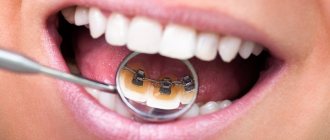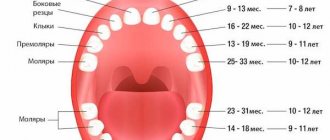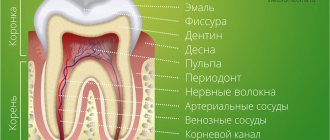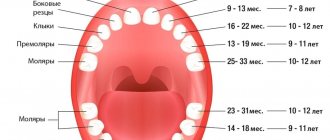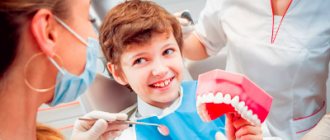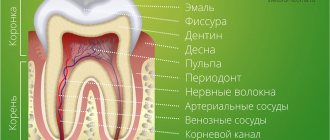Temporary teeth
Timing of teething
Dental buds are formed during the period of intrauterine development. The eruption of the first teeth begins at the twenty-fifth week of the baby’s life. The lower incisors appear first, followed by the upper ones by eight months. The age at which baby teeth, called premolars, erupt varies from one to two years. The last to appear are the canines and second premolars, which occurs from sixteen to thirty months.
This teething schedule is optimal, but it is impossible to determine the exact timing. The process depends on the characteristics of the child’s body, the health of the mother during pregnancy and genetic factors.
Timing of teething in children in the table
| Type of tooth | Lower jaw | Upper jaw |
| Medial incisor | 6 – 10 months | 7 – 12 months |
| Lateral incisor | 7 – 16 months | 9 – 13 months |
| Fang | 16 – 23 months | 16 – 22 months |
| First premolar (baby molar) | 12 – 18 months | 13 – 19 months |
| Second premolar (baby molar) | 20 – 31 months | 25 – 33 months |
The order of teething in children
The teeth follow the principle of pairing, for example, if one fang appears, a second one should be expected soon. The sequence of teething is determined by nature based on the practical significance of dental units for survival.
The front teeth of the lower row grow first, then the upper ones come. The lateral incisors disrupt the order of teeth eruption; their appearance begins with the upper jaw. Then comes the eruption of chewing teeth - the first premolars. The last to emerge are the canines and molars. The process of teething in children is completed by the age of 2-3 years.
Diagram of baby teeth eruption in children
What are molars?
They are formed from the epithelial dental plate: molar rudiments appear only by the fifth month of the mother’s pregnancy. They are divided into two types: replacement - incisors, canines and molars, and additional - molars. The first ones repeat similar teeth in the “milk” set, the second ones have no predecessors.
The rudiments of replacement molars grow in the same alveolus as milk teeth, behind the lingual surface, and over time they are isolated by bone tissue. The rudiments of additional ones are formed only after a year, since the jaw by that time increases in size.
Permanent teeth
Timing of teething in children
The first permanent teeth appear several months before the baby teeth fall out—the molars, or “sixes,” erupt. This occurs at the age of six. By the age of eight or nine years, it is the turn of the incisors. When a child is ten to twelve years old, premolars and canines erupt. Next come the second molars, the eruption of molars is completed by adulthood.
Important!
Wisdom teeth appear much later, after twenty years. However, their complete absence is also the norm.
Timing of teething in the table
| Name | Lower jaw - time of eruption | Upper jaw - eruption time |
| Medial incisor | 6 - 7 years | 7 - 8 years |
| Lateral incisor | 7 - 8 years | 8 - 9 years |
| Fang | 9 - 10 years | 11 - 12 years |
| First premolar | 10 - 12 years | 10 - 11 years |
| Second premolar | 11 - 12 years | 11 - 12 years |
| First molar | 6 - 7 years | 6 - 7 years |
| Second molar | 11 – 13 years | 12 - 13 years old |
| Third molar | 17 – 21 years old | 17 – 21 years old |
Teething order
The pairing principle also applies to permanent dental units. The correct sequence of teething is important for the formation of the bite; it is necessary to carefully monitor the time of loss of baby teeth and the order of growth of molars.
The lower molars appear first, then the upper ones. Next, the temporary teeth of the lower jaw fall out, the permanent teeth erupt, and only then the upper dental units are replaced.
This schedule for teething in children is not universal, but if there are significant deviations, you should consult a specialist.
Care and protection
It is necessary to carefully monitor the cleanliness of your child’s teeth at all times. As soon as the first milk teeth emerge from the gums, they need to be cleaned of plaque and mucosal hygiene must be maintained. But special attention must be paid to oral hygiene throughout the period of changing teeth and the appearance of molars.
The enamel on newly grown permanent teeth is weaker than on already formed teeth in an adult. They are many times more susceptible to pathogenic microbes and mechanical damage.
Important! If hygiene is not maintained until the teeth are replaced, the first molars that grow in the middle of the teeth change process will become vulnerable to carious lesions.
Tooth loss usually does not cause discomfort. New molars also grow almost painlessly. Therefore, many parents who do not devote enough time to the hygiene of baby teeth miss the moment when the molars have grown. And some people learn that the first molars are already permanent and will not change, only in the dentist’s office, when they come to fill a child’s damaged tooth.
Mineralization of the enamel of molars occurs gradually. And until it is completed, the teeth are vulnerable to numerous damages. During the period of their growth and formation, it is advisable to consult a dentist for procedures that strengthen the enamel layer and protect the dental tissue.
The dentist can coat the tooth surface with calcium, perform fluoridation, silver plating and fissure sealing to protect the natural grooves located on the chewing surface of the tooth from abrasion. Read our article about the order of teeth growth in children.
Signs of teething
Symptoms of teething in infants
The appearance of baby teeth is a little more difficult than that of permanent teeth, since the baby has not yet encountered pain and cannot understand what is happening to him. Teething in children under one year of age is accompanied by the following signs.
- The most common symptom of teething is fever. An increase to 38 degrees within three days is normal.
- Swelling of the gums. Often, when children are teething, their gums swell, their sockets itch, and they have a desire to chew hard objects. It is important to prevent the child from damaging the mucous membrane; it is better to buy a special teether to relieve discomfort.
- Decreased appetite. Children refuse to eat due to stress or itchy gums.
- Teething syndrome. Neurosis, tearfulness, anxiety, poor sleep and whims may indicate the imminent appearance of the first tooth, even if the child does not experience pain, fever or swelling of the gums.
Important!
An increase in white blood cell levels during teething should not be a cause for alarm. This is a common occurrence associated with a weakened immune system.
Symptoms of eruption of permanent teeth
A change in temporary bite is accompanied by other unpleasant sensations. The process has the following characteristics.
- Root resorption and loss of baby teeth. A sure signal of the appearance of a new tooth in the coming months.
- Increase in jaw bone size. Permanent teeth are larger than baby teeth, the jaw grows, creating conditions for a change in bite.
- Pain in the gums. Redness and swelling of the mucous membrane are a reaction to teething.
Important!
Body temperature above 38 degrees, cramps, refusal to eat and difficulty breathing are not symptoms of the appearance of milk and permanent teeth. These are signs of an infectious disease. It is necessary to urgently consult a doctor.
How to improve your baby's well-being
When the unit cuts the gum, pain and burning appear. The tissues become inflamed and constantly itch. The inflammatory process can be so severe that the baby will have a fever for several days.
To help him, parents need to use:
- Special pharmacy teethers. These are safe silicone toys that contain a cooling solution inside. They must first be placed in the refrigerator and then given to the child. When the baby chews on the teether, it will create the effect of a massage and a cold compress, which will somewhat muffle the negative symptoms.
- Anesthetic dental gels. They usually contain benzocaine, an effective anesthetic. When applied topically, it reduces gum sensitivity. Also, group drugs may include lidocaine hydrochloride monohydrate, herbal anti-inflammatory extracts. When choosing a medication, it is important to consult a pediatrician. Anesthetic dental gel can be applied only if it is not contraindicated for the child. It is important not to use the product too often, as it can cause allergies or other negative side reactions.
- Wipe off saliva in a timely manner. If you do not do this, the secretion of the salivary glands will irritate the delicate skin around the mouth and chin. Then the unpleasant symptoms of inflamed gums will be aggravated by a burning sensation on the outside.
- Give a non-steroidal anti-inflammatory drug if necessary. Ibuprofen-based products are suitable for children over three months of age. After using them, the body temperature drops and the pain goes away for a while.
- Massage the gums. Some guys have very strong itching. In this case, you can do a massage. The parent needs to wrap the index finger with a bandage, moisten it with water and gently massage the inflamed area. Thanks to these actions, the pain subsides. But, if the child does not allow this procedure, it is better not to insist.
The eruption of baby teeth is a long and complex process. You need to be prepared that ailments will soon be a thing of the past, and be attentive to the condition of the baby. If you have any questions regarding your general health or bite characteristics, you should immediately contact a specialist.
Painful teething: advice for parents
When faced with teething in children, many parents are at a loss. First of all, you need to call an ambulance and determine the reason for the baby’s poor health. If symptoms are confirmed, the specialist will prescribe medications for teething - antipyretics and painkillers.
You can treat your gums yourself with an anesthetic gel with a cooling effect to reduce itching and swelling of the mucous membrane. Ice will also help. To reduce gum irritation, there are special silicone fingertips made of hypoallergenic material.
Folk remedies for teething will effectively relieve painful sensations - a decoction of chamomile, sage, tincture of valerian and honey will soothe inflamed tissues.
Painkillers for teething are contraindicated in children; this can worsen their health.
Important!
Without a doctor's recommendation, antibiotics and other strong teething medications can cause an allergic reaction.
Deviations in teething
Minor changes in the timing and sequence of dental growth should not cause alarm. However, significant deviations from the norm in teething are a cause for concern.
- The tooth does not appear for a long time. Reason: genetic predisposition to long eruption or lack of rudiments.
- Too early appearance of teeth. Caused by disruption of the endocrine system.
- Black or brown enamel surface color. Indicates high iron levels, poor salivation, or chronic inflammatory processes in the child’s body.
- Incorrect row position. Bite pathologies indicate a hereditary factor or deformation of the maxillofacial bone.

